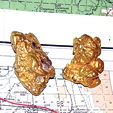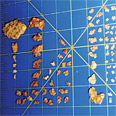All Articles
Legislative and Regulatory Update
December 2002 by Staff
• Federal election results should be favorable to minersThe somewhat unexpected change of leadership in the US Senate could mean some relief from the extreme environmental policies and regulations that have come out of Washington for many years. Republicans, historically more supportive of mining and private property rights, will have control of the House of Representatives, the Senate, and the White House.
We’re still waiting to hear the Interior Department’s recommendations regarding bonding. Numerous suggestions have been made, including the use of bonding pools similar to what is currently being used in Alaska and Nevada.
In a bonding pool, each miner contributes, and fees gathered from a large number of miners provides a pool of money to cover reclamation costs for those who default.
Laura Skaer, executive director of the Northwest Mining Association (NWMA), said her association recommended a two-track system that would include a number of insurance tools. One instrument would cover specific and measurable reclamation, like grading and moving dirt. Another instrument, possibly an annuity or trust, would provide for less certain expenses, such as water treatment or testing. NWMA has also suggested using a secondary federal bond pool.
Miners only have a few more weeks to file for extensions for Notices that were on file with the Bureau of Land Management (BLM) on or before January 20, 2001. These notices will expire January 20, 2003, if not extended. To extend the notice, you must notify the BLM in writing and establish a financial guarantee in accordance with regulations at CFR 3809.300(a) and 3809.503 that were finalized in January 2001. After filing your extension, you must wait to conduct activities until your financial guarantee is approved. Extensions can be granted for up to two years, and operators can file for an extension more than once.
Reviews of forest management policies and the National Environmental Policy Act are also under way. Some of most restrictive procedures are expected to be revised in favor of mining and logging. We will continue to report on them in this column.
Miners are certainly welcoming the administration’s approach to enforcing existing mining laws. The Interior Department has asked the Justice Department to intervene on behalf of Oil-Dri Corporation. Oil-Dri wants to establish a mine on BLM land in Nevada, but has been battling local tribes, environmentalists, and a Washoe County commission. The county commission rejected Oil-Dri’s request to build a processing plant on land adjacent to the mine. Oil-Dri has filed suit in federal court seeking damages from the county.
Bob Abbey, BLM state director for Nevada, stated, “We believe they have valid, existing mining rights under the law.” He said the Justice Department has been asked to file a brief in the case in support of the mine.
Justice Department lawyers recently asked a federal judge in Reno for more time to decide whether or not to enter the case on behalf of the miners.
• Utah residents reject proposed National Monument
The Bush administration, as one of their first moves, declared that National Monument designations should be guided by local input. We’ll see if the administration sticks to their recommendations.
Voters in Emery County, Utah, made it clear in a non-binding vote that they do not approve of a proposed 620,000-acre San Rafael Swell National Monument. Of course environmental extremist groups like the Sierra Club and Wildlands Project were pushing for the designation.
Utah Governor Mike Leavitt and the Bush administration stated they would back off the idea if the county opposed it.
• Fish and Wildlife Service told to disclose locations of endangered species
The National Association of Home Builders (NAHB) recently announced a victory against the US Fish and Wildlife Service (FWS) regarding supposed endangered species.
NAHB had requested the locations of alleged endangered (cactus ferruginous) pygmy owls via the Freedom of Information Act (FOIA), but the federal agency refused. The agency argued that disclosing the location of the birds’ habitat would cause birdwatchers to trespass on private property. The US Court of Appeals for the District of Columbia ruled that FWS must disclose this information.
FWS previously claimed hundreds of thousands of acres were needed as habitat for the pygmy owl in Arizona, despite the prevalence of the species in neighboring states and Mexico. Some believe habitats of many alleged endangered species will be drastically reduced once the FWS is forced to disclose the locations where they can be found. Disclosure will allow others to prove, or disprove, the FWS data.

© ICMJ's Prospecting and Mining Journal, CMJ Inc.
Next Article »« Previous Article
Additional articles that might interest you...
Montana Approves Stillwater Expansion Bonds
August 2000
The Montana Board of Investments unanimously approved a motion to issue up to $35 million in bonds to help Stillwater Mining Corp. expand its platinum and palladium mine.
The Montana Board of Investments unanimously approved a motion to issue up to $35 million in bonds to help Stillwater Mining Corp. expand its platinum and palladium mine.
How Deep Can That Detector Go?
April 2021
 Knowing how to get the greatest depth performance out of your detector can be a handy thing, but it’s not an easy, simple matter.
Knowing how to get the greatest depth performance out of your detector can be a handy thing, but it’s not an easy, simple matter.
Prospecting With a Detector: Lessons Learned
November 2012
 That is the course and intention for this article—to wander through some of the lessons I have learned in my thirty-two years of metal detecting and prospecting.
That is the course and intention for this article—to wander through some of the lessons I have learned in my thirty-two years of metal detecting and prospecting.
 That is the course and intention for this article—to wander through some of the lessons I have learned in my thirty-two years of metal detecting and prospecting.
That is the course and intention for this article—to wander through some of the lessons I have learned in my thirty-two years of metal detecting and prospecting.
Mining Stock Quotes and Mineral & Metal Prices
October 1999
MMAC & PLP Update
December 2015
We have been playing defense for 100% of the game, and now we are finally playing some offense.
We have been playing defense for 100% of the game, and now we are finally playing some offense.
Rediscovering Placerville, California Part II
March 2011
To get to the gold, the miners had to remove the shale pieces and stack them on the sides while sluicing the remaining material through their boxes.
To get to the gold, the miners had to remove the shale pieces and stack them on the sides while sluicing the remaining material through their boxes.
Subscription Required:
The Bawl Mill
• Original Sixteen-to-One Mine Fights On
• Solar-Powered Placer Sampling Equipment
• Working the Belmont Mine—1953 (Part 3—Conclusion)
• Company Notes
• Picks & Pans: Gold and Bears
• Gold in North Dakota
• The North Star Mine
• Dectecting Alaskan Gold Nuggets
• The Ancient History of Gold
• Columbians Continue Search for Emeralds
• Mining Stock Quotes and Mineral & Metal Prices
• Melman on Gold & Silver
Free:








